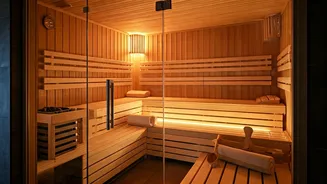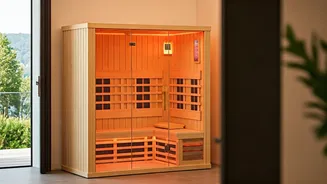Saunas: An Introduction
At-home saunas have surged in popularity as people seek accessible ways to enhance their well-being. These personal havens offer a range of health benefits,
from muscle relaxation to improved cardiovascular health. The experience involves sitting in a heated room, typically between 150°F to 195°F (65°C to 90°C), where the body perspires, helping eliminate toxins and easing tension. Before you buy one, it's vital to research the different types of saunas available. This foundational understanding is key to making an informed decision that aligns with your space, needs, and preferences. Preparing yourself with this knowledge is crucial before taking the plunge into the world of home saunas, ensuring you get the most out of your investment.
Infrared Saunas Explained
Infrared saunas utilize infrared lamps to emit radiant heat that warms the body directly rather than heating the air. They operate at lower temperatures, typically ranging from 120°F to 140°F (49°C to 60°C), making them a gentler option for those sensitive to high heat. The infrared rays penetrate deeper into the skin, promoting detoxification and pain relief by easing muscle aches. This direct heating method is often preferred for its efficiency and ease of use, as it warms the body more quickly than traditional saunas. When choosing an infrared sauna, consider features like the type of infrared emitters (ceramic, carbon), the size, and the materials used in construction to ensure it fits your needs and space.
Traditional Steam Saunas
Steam saunas, also referred to as Finnish saunas, are classic options that heat the air using a heater, often with hot rocks. These rocks are occasionally doused with water to produce steam, elevating humidity levels and intensifying the heat. Temperatures in steam saunas typically range from 150°F to 195°F (65°C to 90°C). The high heat and humidity promote sweating, which is beneficial for detoxification and respiratory health. When selecting a traditional sauna, consider the heater type, the wood used for the interior (cedar and redwood are popular choices), and the size to accommodate your space and preferences. Regular maintenance, including cleaning and occasional rock replacement, is crucial to ensure the sauna's longevity and performance.
Size and Space
Deciding on the appropriate size and location of your home sauna is essential before making a purchase. Consider the available space in your home and how many people you anticipate using the sauna simultaneously. Smaller saunas are suitable for individuals or couples, while larger models can accommodate families or social gatherings. Measure your space precisely and ensure there's enough room for comfortable movement and ventilation. Location matters; saunas can be installed indoors, such as in a bathroom or spare room, or outdoors, provided the area is protected from the elements. Consider proximity to electrical outlets and water sources for convenience and safety. Planning the installation layout will ensure a smooth process and the sauna fits perfectly within your home.
Materials and Features
The materials and features of a home sauna significantly impact its durability, performance, and overall user experience. Wood choices, such as cedar and redwood, are common for their resistance to moisture and natural aesthetic appeal. Features to consider include lighting, which can range from basic overhead fixtures to chromotherapy options that use colored lights to promote relaxation and well-being. Ventilation is crucial for maintaining air quality and preventing mold or mildew. Look for adjustable vents that allow you to control the airflow. Additional features may include built-in sound systems for music, digital control panels for temperature and timer settings, and comfortable seating. Consider these elements based on your budget and desired level of comfort.
Installation and Safety
The installation process is critical for the safety and functionality of your home sauna. While some individuals opt for DIY installation, it's generally recommended to hire a professional, especially for electrical and plumbing connections. Ensure that the sauna is installed on a level surface and that all electrical wiring complies with local building codes. Adequate ventilation is also essential to prevent moisture buildup and ensure air quality. Prioritize safety by installing a GFCI (Ground Fault Circuit Interrupter) outlet to protect against electrical shocks. Always read and adhere to the manufacturer's instructions for installation and operation. Regular inspections are also recommended to identify any potential problems or maintenance needs.
Benefits of Sauna Use
Regular sauna use offers a range of potential health benefits. The heat helps to relax muscles, alleviate joint pain, and reduce stress levels. The intense sweating helps to eliminate toxins, promoting improved skin health and overall detoxification. Some studies suggest that regular sauna use may improve cardiovascular health by increasing blood flow. However, it's crucial to consult with your doctor before starting regular sauna sessions, especially if you have underlying health conditions. Always stay hydrated by drinking plenty of water before, during, and after your sauna session to counteract fluid loss. Listen to your body and exit the sauna if you feel unwell.
Making the Most
To maximize your home sauna experience, prepare appropriately. Shower before entering the sauna to cleanse your skin and enhance sweating. Stay hydrated by drinking plenty of water. Set a comfortable temperature and timer. Limit your initial sessions to 10-15 minutes, gradually increasing the duration as your body acclimates. Use a towel to sit on and absorb sweat, keeping the sauna clean. After your session, cool down gradually, by showering or resting in a cool area. Consider incorporating aromatherapy by adding essential oils to the water (for steam saunas only) for an enhanced sensory experience. Consistent use, combined with a healthy lifestyle, will help you reap the maximum benefits from your home sauna.











